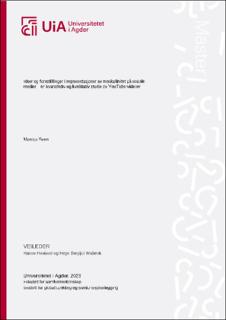| dc.description.abstract | Abstract
The phenomenon the manosphere has been a subject of growing interest in academic research for the past five years. In its mention the manosphere is often associated with words such as misogyny and antifeminism. The term originated in a blog post in 2009, and it was later popularized by the blogger and author Ian Ironwood: “The Manosphere is a loose collection of blogs, books, and forums about men, male issues, and masculine interests” (Ging, 2017). Later on the academic and popular discourse seem to define the manosphere as a conglomerate of online groups, bounded together by the overarching red-pill philosophy which serves as a world ontology for the rationalisation of male victimhood and hate against women (Ging, 2017). This world ontology is centred around the belief that the cultural and institutional practices of society are in fact deeply rooted in an antifeminist misandry (hate against men). Using an analogy from the sci-fi movie The Matrix, the red pill symbolizes enlightenment for the men who have discovered the truth about the world in which women are favoured. These groups are often considered the online manosphere groups: Men Going Their Own Way (MGTOW), Pickup Artists (PUA) and Men’s Rights Activists (MRA) (Ging, 2017; Valkenburg, 2021; Marwick \& Caplan, 2018). A majority of the research has been centred around the communities in which these members interact, in particular Reddit forums, and consists of qualitative analysis of posts and comments in various forums belonging to the manosphere (Bujalka et al., 2022).
In this thesis I seek to understand how the ideas of the manosphere have spread and morphed into expressions and representations of masculinity in YouTube videos. This approach is based on the assumption that the boundaries of the manosphere are not easily identifiable when moving beyond websites and forum groups. My focus is on representations of masculinity rather than representations of the manosphere, thus allowing for more diverse sentiments and expressions of masculinity in my dataset.
Due to my technical background in IT and software development, I have been able to use a multidisciplinary research methodology. Using automated data retrieval with Google’s YouTube API combined qualitative content analysis, this multidisciplinary approach has enabled a richer description of the phenomenon, representations of masculinity.
My findings show that videos posted by YouTubers associating themselves with MGTOW have been present since 2011. Representations of masculinity labelled red pill and the manosphere were scarce in 2015, reaching the level of magnitude in scope and popularity as seen today in 2018. My findings also suggest that ideas associated with the manosphere, such as the depiction of the male archetype the alpha male, constitute a trend which is exploited for commercial purposes such as self-help and motivation videos that are not necessarily linked to misogynistic content. The first occurrences of these self-help and motivation videos were around 2020. This indicates that both the popularity growth of YouTube-content associated with the manosphere and the growth of YouTube as a social media platform (Ruby, 2023) have led to the formation of a commercial market built upon masculinity ideals. | |
